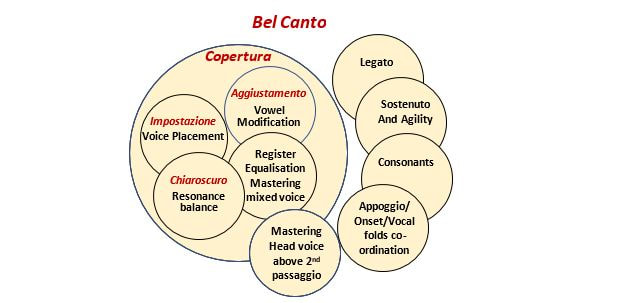|
What is “Good Singing”? Written for Walton Voices by Zoran Milosevic [email protected] 01932 246 635 Most people would agree that the underlying principles of all good singing are:
The large topic of Copertura is at the root of the characteristic operatic vocal timbre, and takes many years of vocal training to master. The meaning of the word is “voice covering”, but the term encompasses a much broader range of techniques than what is normally associated with “covering” in English or “Deckung” in German, which signify the timbre and voice changes around the zone of passaggio.
The “legato” and “sostenuto/agility” marks are shown at the top of the chart to indicate their supreme importance, although it is impossible to separate the above topics from one another. There is no legato nor sostenuto without agility, there is no agility without a firm tone onset, which is non-existent without adequate breath control, etc. Pavarotti once said something on these lines: “The instruments like piano or violine are easily made available to you but are difficult to learn how to play. The instrument “voice” is difficult to make available, but once you have it, it is very easy to play”. And how do good singers achieve all that? Well, by starting from the basic principles: good breathing, good support, a feeling of forward clarity and lightness in the voice, a loose throat, a healthy tone onset and understanding and having an imaginative picture of the vocal space, and … many years of structured vocal training. Si Canta Come Si Parla (one sings as one speaks) is a famous adage of the old Italian school, but often misunderstood. Certainly, speaking and singing are not the same thing, but the expression has another, more profound meaning. In the first year of your singing lessons, a competent teacher will develop your instrument by starting from the speaking voice, gradually transitioning it into the singing voice. But that is not what the expression refers to – the true meaning is that after many years of classical training, and achieving a flexible vocal position that allows for modification of the vowels when acoustically necessary, premier singers complete the cycle and return to “speaking” the song. To premier singers singing feels as if they do some kind of prolonged speaking. There is no great singing without that transformation. We will tackle this in more detail in one of subsequent posts. To finish this article, let me return to that greatest asset in singing – the pitch control and the ability to stay in tune. Even without vocal training, some fortunate individuals possess excellent pitching ability, and those less fortunate find it difficult, even impossible, and view the talent of the former with amazement and incredulity, especially watching them sight-singing. People belonging to the second category may call themselves tone deaf. However, true tone deafness occurs only in a tiny percentage of population. Those who think that they cannot pitch notes will often find that they can actually detect if someone else’s singing is out of tune. Their actual “problem” comes from an apparent difficulty to properly connect the brain and larynx and issue instructions for the vocal folds to produce the correct pitch, a neural wiring malfunction that is correctable by vocal training. These “untalented” individuals can become great singers, albeit they may find that it takes them a bit longer to gain firm enough command of a song or a melody, sufficient for the intonation to be excellent, be it in a solo, or even more so in ensemble singing.
3 Comments
Leave a Reply. |
It's good to share!Got something you'd like to share with us all? Perhaps some interesting research, an event or experience or some other art, media or enterprise that you'd like to contribute. Archives
May 2021
Categories |


 RSS Feed
RSS Feed